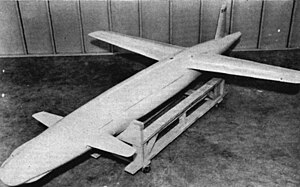KA2N Gorgon IIA
| KA2N Gorgon IIA | |
|---|---|
 Gorgon IIA | |
| Type | Air-to-air missile |
| Place of origin | United States |
| Service history | |
| In service | 1945–1946 |
| Used by | United States Navy |
| Production history | |
| Designer | Naval Aircraft Modification Unit |
| Designed | 1945 |
| Manufacturer | Singer Manufacturing Company |
| No. built | 21 |
| Specifications | |
| Mass | 971 pounds (440 kg) |
| Length | 14 feet 6 inches (4.42 m) |
| Wingspan | 11 feet (3.4 m) |
| Engine | one Reaction Motors CML2N liquid-fuel rocket 350 lbf (1,600 N) thrust for 130 seconds |
Operational range | 25 miles (40 km) |
| Maximum speed | 500 mph (800 km/h) |
Guidance system | Television guidance |
| References | Parsch 2005[1] |
The KA2N Gorgon IIA – also designated KU2N, CTV-4, and CTV-N-4 – was an air-to-air missile developed by the United States Navy near the end of World War II. Proving a failure in its designed role, it was repurposed as an experimental testbed for missile technology.
Design and development
[edit]The Gorgon missile program began in July 1943 at the Naval Aircraft Modification Unit in Warminster, Pennsylvania, and was intended to develop a family of small air-launched missiles for air-to-air and air-to-surface roles.[1] The Gorgon IIA, the baseline design of the family, was of canard configuration, a conventional high-mounted monoplane wing providing lift; the structure was largely of laminated wood,[2] while propulsion was by a Reaction Motors CML2N liquid-fuel rocket,[1] fueled with monoethylamine and nitric acid.[3]
Intended for use intercepting bombers or transport aircraft, the Gorgon IIA was said to be the first American guided missile to be powered by a liquid-fueled rocket.[2] It was fitted with a television guidance system, the pilot of the launching aircraft controlling the missile via radio based on the view from a camera mounted in the nose of the missile.[2]
Operational history
[edit]Production of the Gorgon IIA, designated KA2N-1, was ordered from the Singer Manufacturing Company,[4] a sewing machine manufacturer.[5] A mockup of the missile's configuration was approved in March 1944,[6] and by April 1945, orders for 21 Gorgon IIA missiles had been confirmed,[1] all of which would be built.[2] However, initial flight tests of the system, beginning as unpowered glides early in 1945 and proceeding to fully powered guided trials in March 1945, showed that the guidance system was impractical; the closing speeds of the missile and its target were too great for the Gorgon IIA's limited maneuverability to allow the missile's operator to correctly steer the weapon.[1] Despite this difficulty, the Gorgon IIA was the first jet- or rocket-powered radio-controlled aircraft to successfully fly in the United States.[7]
The control issues, combined with the overall immature state of missile technology, led to the Gorgon program being realigned as a testing program; the Gorgon IIA being redesignated in 1946 as KU2N-1, then CTV-4 in 1947, and finally as CTV-N-4 in 1948;[1] the CTV designation reflecting its status as a control test vehicle,[4] although the program was largely concluded by that point.[2] Despite the difficulties with its guidance system, the Gorgon IIA was considered aerodynamically satisfactory.[1]
Gorgon IIB
[edit]A turbojet-powered version of the Gorgon II missile, Gorgon IIB, was also ordered, with four examples being contracted for;[1] the project was cancelled due to a lack of suitable engines.[4]
Surviving aircraft
[edit]
Very few Gorgon IIAs survived the testing program. One was donated by the U.S. Navy to the National Air Museum (now the National Air and Space Museum) in 1951; it is currently on display at the Steven F. Udvar-Hazy Center.[2]
References
[edit]Citations
[edit]- ^ a b c d e f g h Parsch 2005
- ^ a b c d e f "Gorgon IIA Missile". National Air & Space Museum. Smithsonian Institution. 27 September 2016. Retrieved 2017-12-05.
- ^ Bowman 1957, p.124.
- ^ a b c Ordway and Wakeford 1960, p.181.
- ^ "Links to the Past: Michiana History – Record Detail: Singer Sewing Machine Company – 1927". South Bend, IN: St. Joseph County Public Library. Retrieved 2017-12-06.
- ^ White 1991, p.36.
- ^ "Navy Guided Missiles". Astro-Jet (18). Reaction Research Society: 11. Fall 1947. Retrieved 2017-12-06.
Bibliography
[edit]- Bowman, Norman John (1957). The Handbook of Rockets and Guided Missiles. Chicago: Perastadion Press. ASIN B0007EC5N4.
- Ordway, Frederick Ira; Ronald C. Wakeford (1960). International Missile and Spacecraft Guide. New York: McGraw-Hill. ASIN B000MAEGVC.
- Parsch, Andreas (4 January 2005). "Martin ASM-N-5 Gorgon V (and other NAMU Gorgon variants)". Directory of U.S. Military Rockets and Missiles, Appendix 1: Early Missiles and Drones. Designation-Systems. Retrieved 2017-12-05.
- White, Maxwell (1991). An Interpretative History of the Pacific Missile Test Center: The Genesis, Road to Point Mugu, 1936–1946. Point Mugu, CA: Pacific Missile Test Center. ASIN B00010AIGU.
External links
[edit]![]() Media related to CTV-N-4 Gorgon IIA at Wikimedia Commons
Media related to CTV-N-4 Gorgon IIA at Wikimedia Commons
